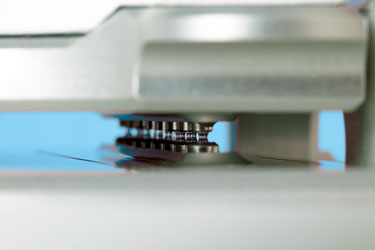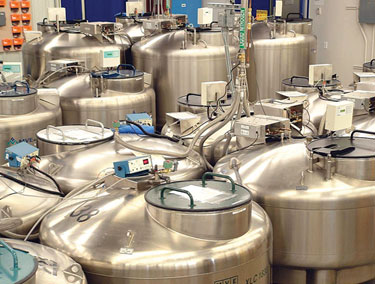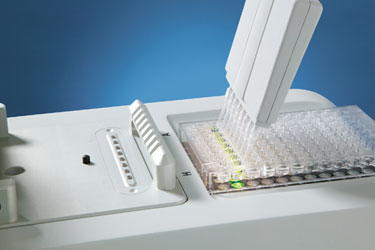September 1, 2008 (Vol. 28, No. 15)
Joel Hansen Ph.D.
Philippe Desjardins Scientific Marketing Consultant Venture Novo, LLC
Facilitating High-Throughput Processing At Biorepositories Around the Globe
High-volume facilities such as biorepositories are beginning to make a fundamental shift away from fluorescence quantitation methods to direct spectroscopic absorbance measurements. This trend can be attributed to the introduction of higher-throughput, 1 µL absorbance instrumentation.
The use of microvolume sample-retention technology for 1 µL spectroscopic analysis has been widely accepted in many disciplines. It represents an essential change from systems reliant on containment devices such as cuvettes and capillaries to systems that have removed containment devices from the process altogether.
A sample retention system that uses inherent surface tension to capture and hold 1 µL samples between two optical fibers for spectroscopic analysis was introduced in 2000 by NanoDrop Technologies, now part of Thermo Fisher Scientific.
The Thermo Scientific NanoDrop 1000 Spectrophotometer represented a significant improvement over traditional cuvette-based systems in terms of overall speed and efficiency. Yet, performing measurements one sample at a time was simply impractical in high-throughput settings such as biorepositories and other high-volume environments.
To address the need for high-throughput microvolume quantitation, the Thermo Scientific NanoDrop 8000 Spectrophotometer was developed to measure eight, 1 µL samples at a time. When measuring samples in a 96-well format on the NanoDrop 8000, the researcher uses an eight-channel pipettor to draw 1 µL samples from a microtiter plate and dispenses the samples onto an array of eight optical measurement pedestals. Once loaded, an upper array of optical pedestals engage the samples to create liquid columns between the optical surfaces (Figure 1).
A xenon flash lamp fires through the samples vertically, and the transmitted light is collected by an internal spectrometer. The distance between the pedestals defines the path length and can change in real time to ensure measurement of a large dynamic range of sample concentrations (e.g., 2 ng/µL to 3,700 ng/µL for double-stranded DNA). The system works by measuring the samples at a 1 mm path length as well as a shorter path length during the same measurement cycle.

Figure 1
DNA Biorepository
The increase in efficiency from single-sample to eight-sample microvolume quantitation has made a significant impact at the Bionomics Research and Technology Center at Rutgers University. The DNA biorepository comprises over 2.4 million samples and processes hundreds of thousands of samples every quarter (Figure 2).
“The collective results of both the physical and software upgrades have increased efficiency by at least 35 percent to as much as 45 percent,” explains Andrew Brooks, director of the Bionomics Research and Technology Center. “We have gone from NanoDropping 5 percent of our samples to 100 percent of all samples processed.”
Direct feedback from the Rutgers group led to essential design changes of the NanoDrop 8000 to accommodate the high-throughput need. The most significant of these was the development of a Sample Position Illuminator (SPI) that keeps track of samples to be measured by lighting up wells from beneath a 96-well plate. This helps the user identify which wells to draw from for the next measurement, thus reducing fatigue and human error. Prior to measurement, the user selects the samples to be measured from the on-screen position indicator. The user then measures the corresponding wells of samples lit by the SPI (Figures 3A and 3B).
One of the most difficult issues for high-throughput laboratories and biorepositories is readily identifying samples that have concentrations that fall outside a desired range. New software allows upper and lower concentration limits to be defined by the user for cases in which a specific target concentration is desired.
Once the user defines such limits (e.g., 100 ng/µL ± 20 ng/µL), wells that have readings that fall out of a defined range will begin to flash by the illumination system. Cherry picking can be performed by selecting wells of interest that are subsequently lit up by the Sample Position Illuminator. To increase the ergonomic flow, the SPI system also allows the user to select an auto advance feature that increases measurement throughput by automatically lighting up the next column to be measured.
Overall importance of the new measurement system is multifaceted, according to Brooks. “First, the auto advance feature in conjunction with the SPI greatly improves the ergonomics and thus the speed in which samples are measured.
“Second, the newly expanded sample ID loading capability enables flawless flow of information from our standard sample organization that comes off our robotic platforms. Finally, the ease-of-use of the out-of-limit sample feature also impacted the overall speed of sample processing.”
As a result of these improvements, the Rutgers biorepository group has incorporated three NanoDrop 8000 instruments into their workflows.

Figure 2

Figure 3a

Figure 3b
Joel Hansen, Ph.D. ([email protected]), is technology director, and Philippe Desjardins is scientific marketing manager for NanoDrop products at Thermo Fisher Scientific. Web: www.nanodrop.com.







